Elisabeth Hall — March 1, 2013
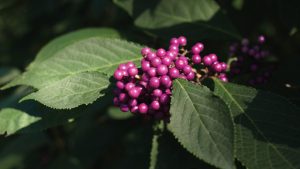
Beautyberry lives up to its name, bearing breathtaking clusters of jewel-toned fruit. But which is the best selection? Trials at Longwood Gardens show what the shrub’s varieties have to offer.
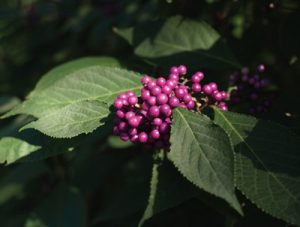
Click image to enlarge.
Callicarpa is called beautyberry for good reason: With its prolific, bright purple fruit, this plant demands attention in its fruiting season. The striking lavender to deep purple color of the fruit covers the shrub in late summer and lasts through the autumn. There are many cultivars available in the trade, and Longwood Gardens in Kennett Square, Penn., put the plants to the test to determine which Callicarpa has the best landscape value.
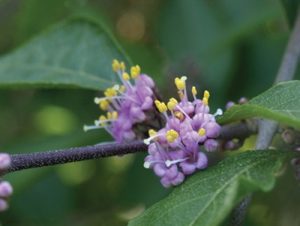
Click image to enlarge.
Callicarpa bodinieri var. giraldii ‘Profusion’ was the highest scoring beautyberry in the trials. Its prolific purple fruits, which form handsome clusters held close to the stems, make an impressive display beginning in late August. Delicate flowers cover the shrub in springtime.
Photos courtesy of Elisabeth Hall
At Longwood, an eight-year trial has evaluated more than 1,200 taxa and 90 genera of landscape shrubs. These shrub trials were designed to test plants for their value in the landscape, and included common garden cultivars alongside plants less common in the trade. Students, volunteers, and horticulture professionals collected data throughout the year on habit, stems, foliage, flowers, fruits, injury, pests and pathogens. Each plant was rated on a scale of 1.0 to 5.0, with 1.0 being “unattractive,” 2.0 “acceptable,” 3.0 “attractive,” 4.0 “very attractive” and 5.0 “best in class.” The plants were maintained minimally after establishment, and were only irrigated, mulched and weeded as needed. During these trials, 19 taxa of Callicarpa were evaluated and a range of opinions was gathered from amateurs and professionals alike. These species and cultivars were compared to determine the best selection of beautyberry.
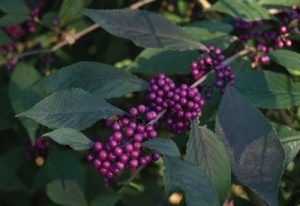
Click image to enlarge.
The beauty of beautyberry
The genus Callicarpa contains approximately 140 species, with the majority occurring in eastern and southeastern Asia. Other species occur in Australia, Central America, and southeastern North America. The name Callicarpa is derived from the Greek callos, meaning beauty, and carpos, meaning fruit. The unusual and prolific lilac-colored fruit of beautyberry (which is actually a drupe, not a berry) is a showstopper in late summer and fall. After leaves drop, fruit may persist for up to six weeks.
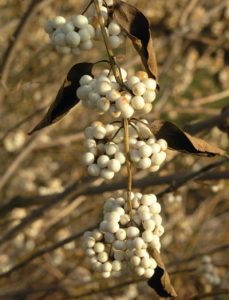
Click image to enlarge.
The cultivar C. dichotoma ‘Shirobana’ stands out from the rest of the beautyberries with its distinctive white berries.
Photo courtesy of Tomasz Anis’ko
A member of the Verbenaceae, Callicarpa has small clusters of pink or white flowers in the spring. The flowers have less ornamental value than the fruit as they are very small, held close to the stem, and covered by leaves.
Self-sown seedlings may occur in the garden with some species, and branches will root if allowed to rest on the ground. Beautyberry is self-pollinating, but some (like the U.S. native Callicarpa americana) perform better when planted in mass. In a grouping, the plants have a better chance for cross-pollination and resulting fruit production.
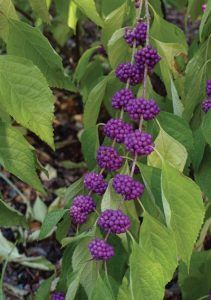
Click image to enlarge.
Callicarpa dichotoma has striking, bright purple drupes and clean lanceolate foliage.
Photos courtesy of Elisabeth Hall
There are different schools of thought on how to prune Callicarpa: It can be treated as a cut-back shrub and cut to 3 to 4 inches in early spring; a few selected branches can be cut back each year; or the plant may be allowed to develop unrestrained on its own. Flowering occurs on new growth and judicious pruning practices may help beautyberry create a prolific fruit display. It should be noted that while these techniques may be recommended, the shrubs in the trials were not pruned and were judged as they grew naturally. Because the shrubs were evaluated regularly in every season, it is possible to get a picture of how beautyberry performs throughout the year.
Performance in spring and summer
Beginning in spring, the ratings for all taxa trialed were low. The relatively demure flowers of Callicarpa cannot compete with other spring blooms, and therefore were not highly ranked. The flowers are not unattractive, but they are small and held close to the stem, usually hidden by foliage. Comparatively, the most striking flowers in the trials belonged to Callicarpa shikokiana, native to China. It produced delicate purple flowers with a pleasant fragrance noticeable in the morning, which impressed the reviewers. This species has a sprawling habit and is fast growing in favorable climates; it did not do well in the trials, however, receiving low ratings due to winter dieback. Despite these setbacks, it did produce abundant purple fruit. The shrub may be expected to do better further south: Jenkins Farmer, in an article titled “Beautyberry” published in the Feb. 1, 1995, issue of American Nurseryman, reported that C. shikokiana thrived in Colombia, S.C.
Summer ratings for most of the beautyberry trialed were “acceptable.” The increase in ratings from the spring was due to the blemish-free green foliage of the shrub and its pleasing upright vase shape. The various cultivars of C. dichotoma received the highest ratings of all the beautyberries during the months of June and July. In August, things began to change and it became clear that beautyberry was worth the wait.
Falling for beautyberry
Beautyberry is at its best in late summer to fall. The striking purple fruit starts to form in August and, depending on the variety, remains attractive on the plant through the fall. The unusual color of the fruit makes it one of the most sought-after plants at this time of year. One of the best performers in the shrub trials in the fall months was Callicarpa dichotoma. A native of China and Japan, it was introduced to the trade in 1857. It is hardier than other species of beautyberry, although the optimum fruit display occurs in warmer climates. It has an upright spreading habit with long arching branches and grows 3 to 4 feet tall. Four cultivars of C. dichotoma were evaluated for their value in the landscape.
The standout among these selections was the cultivar ‘Winterthur’. Its uniform habit and red new growth stood out in the trial. The flowers of ‘Winterthur’ are moderately showy and bloom in July. Small lavender berries peak in October and November, with very attractive clusters of dark purple fruit. This cultivar had mixed reviews in the trials, with some commenters raving over its heavy fruit production and others lamenting the fact that the fruit blackens and persists on the shrub through the winter. It had an average rating of 2.6 and would make a worthy addition to any garden, but may be difficult to find in the trade.
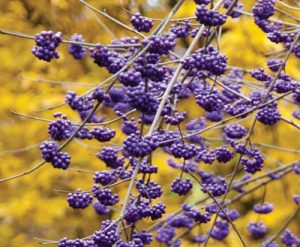
Click image to enlarge.
After leaves drop in the autumn, the bright purple fruit of Callicarpa japonica takes center stage.
Photo courtesy of Tomasz Anis’ko
Another top performer, with an overall rating of 2.6, Callicarpa dichotoma ‘Early Amethyst’ received ratings of “very attractive” during the fall. Introduced by the Arnold Arboretum of Harvard University, this selection produces abundant, deep purple fruit that is darker compared to other cultivars. ‘Early Amethyst’ received positive ratings in the trials due to the exceptional color of its fruit. It was noted that pruning is essential to keep the plant at its peak.
The purple fruit of Callicarpa dichotoma ‘Issai’ covers the shrub from September to October. The cultivar was introduced by Brookside Gardens in Maryland, and produces abundant clusters of small, shiny, dark purple drupes. In the trials, it was noted that ‘Issai’ produces more fruit than the species. In October, ‘Issai’ received “best in show,” the highest rating possible in the trial. The average rating was 2.5, due in part to the fact that the fruit had a tendency to wither and overwinter on the shrub.
Callicarpa dichotoma ‘Shirobana’ grows larger than the species, sometimes reaching 8 feet in height. This introduction from Japan produces snowy white drupes from August through November. The new growth in spring is a handsome red-bronze. Moderately showy white inflorescences with a sweet subtle fragrance are produced in late spring. It was noted in the trial that fruit sometimes persists on the plant over winter and turns an unattractive black. The ratings ranged from “average” to “attractive.” The striking white fruit makes this a plant for someone looking to grow an unusual specimen.
Another interesting variation on beautyberry is C. dichotoma ‘Duet’. Although too new to be included in the shrub trials, ‘Duet’ is a variegated cultivar introduced by the U.S. National Arboretum in collaboration with Tennessee Technological University. ‘Duet’ has white berries from summer to mid-fall and has proved to be a stable variegated beautyberry. So far, it is the only variegated form of C. dichotoma available. Its white berries and interesting foliage make it a plant worth investigating.
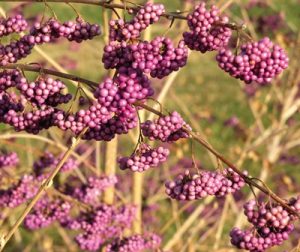
Click image to enlarge.
The heavy fruit set of Callicarpa japonica var. luxurians causes the branches to fall open and the shrub loses its upright form.
Photo courtesy of Tomasz Anis_ko
Another strong performer in the autumn months is Callicarpa japonica. This beautyberry hails from Japan, where it is called “Murasaki-shikibu.” “Murasaki” means purple in Japanese, and “shikibu” refers to the pseudonym of a famous female writer of the 11th century. In Japanese villages, the wood of this species was used for chopsticks and for handles of tools. C. japonica was introduced to Western horticulture in 1845, and many cultivars have been selected since.
One cultivar evaluated was Callicarpa japonica ‘Heavy Berry’. It has an upright yet informal habit, which some commentators marked as a negative trait. The foliage is rough textured, and the plants did not have vigorous growth during the trials. The maroon new growth was appreciated by evaluators, as was the heavy berry set that occurred from August through November. The fruit is most attractive from October to November. ‘Heavy Berry’ is considered more fruitful than the type and did produce copious amounts of fruit. Overall, however, this cultivar did not perform as well as other C. japonica cultivars in the trials, receiving “average” overall ratings.
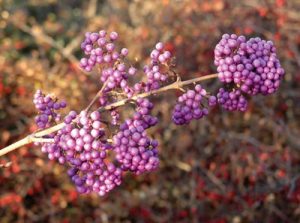
Click image to enlarge.
Callicarpa _ shirasawa sets fruit later in the season than other beautyberries, making it an interesting late fall color in the garden.
Photo courtesy of Tomasz Anis_ko
The best white fruiting beautyberry in the trials, Callicarpa japonica ‘Leucocarpa’, is a shrub with an attractive upright-rounded habit. Its clean, dark green foliage is a welcome contrast to the lighter gray-brown stems and white fruit, a characteristic that sets it apart from other beautyberries. Fruit set causes the branches to bend with the weight, resulting in a lovely pendulous shape. The fruit is persistent through winter, turning black and detracting from the beauty of the plant. (It occasionally occurred as a chance seedling during the trials.) It was observed that without the fruit, this is an average shrub; however, its white berries make ‘Leucocarpa’ an interesting addition to the garden.
Callicarpa japonica var. luxurians is a variety with smaller flowers and is less hardy than the species. It has an upright vase shape, and the foliage is dense. The weight of the abundant, light purple fruit causes the branches to fall open and lose their upright structure, causing one commenter to note that other beautyberries have better form. This variety has larger leaves and larger flower clusters than usual. New leaves are bronze, and new stem growth is dark purple. Moderately showy pink flowers occur in July or August, and light purple fruit forms in October through December. Overall ratings place this variety as acceptable or attractive, but not outstanding.
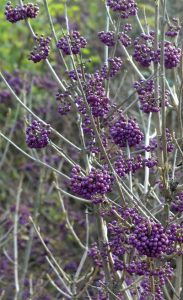
Click image to enlarge.
Callicarpa mollis received the highest ratings in the winter due to its strong structure and attractive bark.
Photo courtesy of Tomasz Anis_ko
Another species of beautyberry, Callicarpa membranacea (syn. Callicarpa japonica var. angustata or C. longifolia), is from Central China, and was introduced to horticultural trade in 1907. It has long, narrow leaves and dark brown stems. Only one of three plants survived in the trial at Longwood, but according to one reviewer, the one that flourished was “very attractive.” It merits more study.
Callicarpa × shirasawana is a hybrid of C. japonica × C. mollis that originated in Japan before 1895. It is a tall plant with an excellent growth habit. It forms a dense and upright shrub to 9 feet tall and wide. The average fruit set peaks in October through November. It was noted that this selection did not have the best berries out of the beautyberries trialed, and had overall average ratings. However, its fruit ripens late in the season and reaches its peak in late October through November. While it is not the most outstanding of the beautyberries, it is a good addition for unusual late color in the garden.
The native North American beautyberry, Callicarpa americana, has a coarser texture and larger leaves than the Asian species. It has large, round purple fruit that contrasts nicely with its light green foliage. Its native range is from Maryland to Florida and west to Texas. In the Longwood trials, the plants failed to establish; however, other local gardens have reported no difficulty with hardiness. It would make a fine addition to a garden of native plants, especially because it is a food source for wildlife in the autumn.
Winter interest
As leaves fall and frost arrives, beautyberry begins to settle in for winter. Overall, the ratings in this season were lower. Fruit has a tendency to wither and persist on the branches, which brought down the scores from the trials. In further observation, the amount of fruit on plants in the winter is not overwhelming, but in many cases does take away from the shrub’s appearance. The branches do not have a defined structure and are not particularly striking. The best performer in the winter was Callicarpa mollis, a species that is native to Japan and Korea and was introduced in 1863. It has an upright form that is more compact than other beautyberries. The light purple fruit is subtle and not as showy from a distance. During the winter months, it ranked higher than other species due to its clean branch structure and attractive bark. Overall, C. mollis received an average to low rating because its fall fruit display did not compete with other species.
And the winner is …
Of all the beautyberries trialed, the overall winner was Callicarpa bodinieri var. giraldii ‘Profusion’. This Dutch selection from seedlings of C. bodinieri var. giraldii was introduced in 1887. ‘Profusion’ has the same large, upright branching habit of its parent and grows 4 to 6 feet tall. It produces more fruit than the species, with copious clusters of purple berries from August to November. In some years during the trials at Longwood, the fruit persisted through January, with the peak display in October.
The foliage is dark green and attractive with a slight purple cast to the petioles and new growth. In part shade, the plant gets lanky, so full sun is recommended. It is fast growing and will produce fruit within a year, an advantage for someone looking for a quick effect in the garden. The flowers are small and light purple. In the winter, its tidy structural form in the landscape led to higher ratings. Gaining a rating of 2.7, ‘Profusion’ was overall a top performer in the trials, providing a lasting and spectacular fruit display.
Although it cannot be argued that Callicarpa has four-season interest, most agree that the fruit display in autumn makes it a worthy addition to the garden. It is not unattractive in other seasons, but the spectacular fruit in the fall trumps any doubts about its spring or summer interest. It can be used for structure in the landscape that reveals its true glory as the last summer days pass. With selections such as Callicarpa bodinieri var. giraldii ‘Profusion’ or C. dichotoma ‘Issai’, fruiting is sure to be extravagant and dependably showy.
Adding one of these shrubs to the garden is a great way to provide contrast to autumn’s prevailing warm colors of trees and shrubs, and complements the pinks and purples of many fall perennials. When placed in the back of a sunny border or bed, the plant blends into the backdrop until August, when it proves that it has earned the name “beautyberry.”
Elisabeth Hall is the curatorial intern and Tomasz Anis’ko is the curator of plants at Longwood Gardens in Kennett Square, Penn. Dr. Anis’ko may be contacted at [email protected].